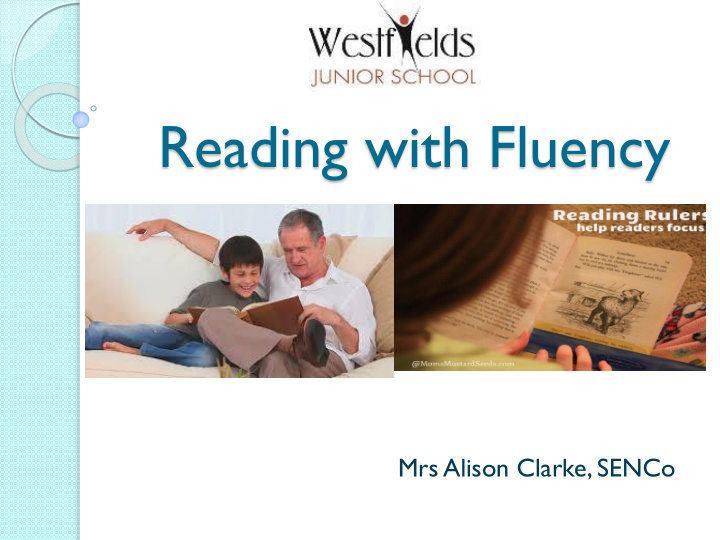



Reading with Fluency Mrs Alison Clarke, SENCo
What makes a good reader? The main purpose of reading is to build a visual image of the text. Decode Attitude Understand Respond
Language Comprehension
Different types of reading Modelled Reading: Reading to your child Modelled allows them to access Reading a higher level of book as they do not need to decode the words Supported Reading themselves. Independent Also, this helps to Reading build vocabulary and demonstrates fluency.
Different types of reading Supported Reading: Reading with your Modelled child allows them to Reading read a book with an adult to support in the decoding of Supported Reading words and checking understanding of Independent vocabulary. Reading
Different types of reading Independent Reading: Reading Modelled independently is Reading important for children to ‘have a go’ at the skills of decoding and Supported Reading word recognition. Independent It allows children to Reading self-correct their reading when it doesn’t ‘sound right’.
3 steps to success: 1. Book and text selection 2. Perseverance 3. Enjoyment!
1. Book and T ext Selection Discuss the book before choosing it. Prediction - What do you think it will be about? What front cover clues do you have? Read the blurb on the back of the book. When you find an author that your child likes, read several of their books as it’s easier to predict what’s coming next if their style is familiar. Find the motivational books (e.g. Project X – Low R.A. /High interest level, Barrington Stokes – Dyslexic type difficulties) Children respond well to interactive media too!
1. Book and T ext Selection This is an example of what reading might feel like for a child with 60% reading accuracy.
1. Book and T ext Selection This is an example of what reading might feel like for a child with 90% reading accuracy.
1. Book and T ext Selection This is an example of what reading might feel like for a child with 94-95% reading accuracy.
2. Perseverance If your child gets stuck on a word: Sound it out: Encourage your child to break the word down. Help if necessary. Context: Help them to work out what the word means from the rest of the sentence...this it narrows it down. Paired Reading: Knock & nudge.
3. Enjoyment! Paired Reading (You read: I read) Re-reading of favourite books Making it part of routine Read to your child Model the joy of reading!
Barriers in Developing Reading Fluency Lack of practise Concentration T ext that is too complex Anxieties around reading Fear of failure
Does your child prefer TV, computers or football to reading? These leisure activities should be balanced with reading time. If children have a short concentration span, find books that are short, exciting and satisfying and match their interests. Use e-books and quality reading materials for mobile devices. Look at the Oxford University Press Owl website...
Books are DOES THIS SOUND FAMILIAR? boring! Avoidance tactics -Your child may be worried about failure and aware that their reading skill is not yet as good as others. ‘If you find something difficult you need to practise more!’ Fiction is important because it feeds the imagination and introduces children to a wide range of experiences. Factual books help your child’s understanding of the world. Do not give up! Reading is an essential skill and is the key to success at school.
Well done! Excellent And finally... effort and concentration! Praise and encouragement are • essential. Enthusiasm is catching so never • imply that reading is a chore. Find the right time for both of you. Enjoy this special time • together.
Recommend
More recommend